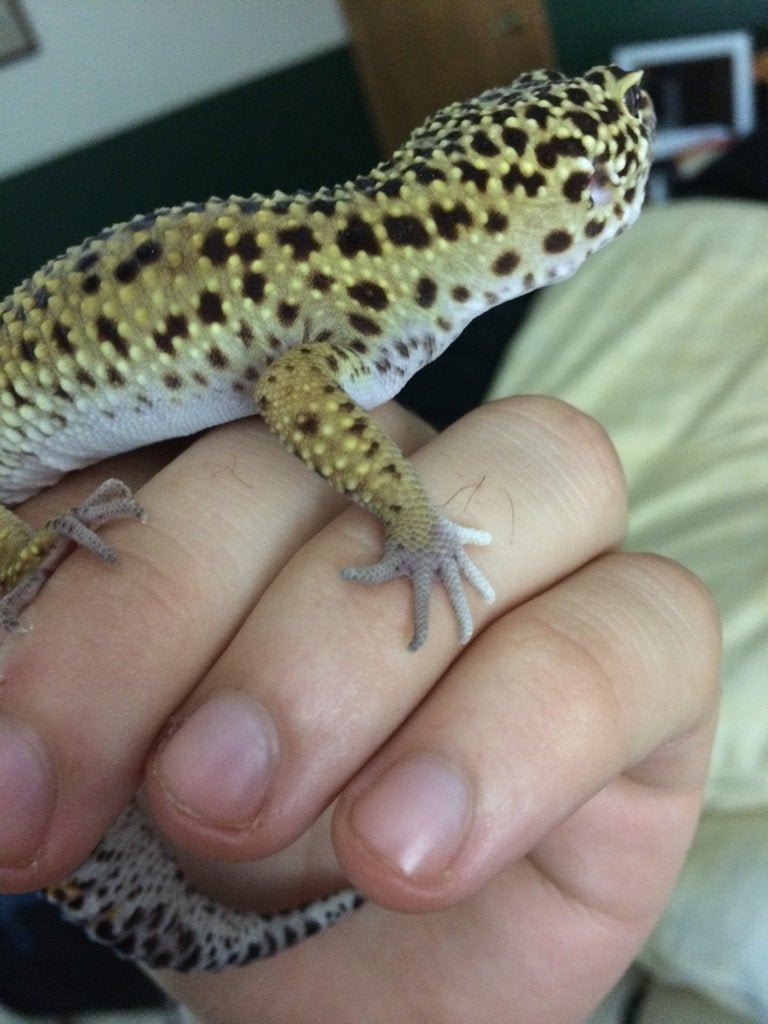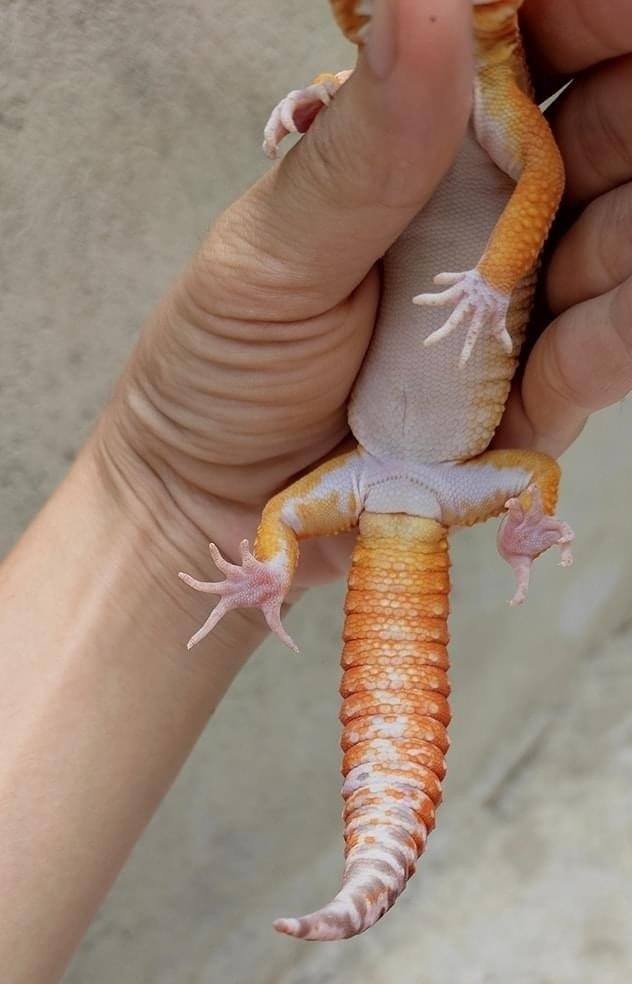Why are My Leopard Geckos Toes White

There are a few reasons your leopard gecko’s toes may turn white. One reason is if your gecko isn’t getting enough calcium in its diet. Calcium is important for strong bones and muscles, so without enough of it, your gecko’s bones may start to weaken, which can cause the toe tips to turn white.
Another possibility is that your gecko is suffering from a vitamin A deficiency, which can also lead to bone problems. Make sure you are feeding your leopard gecko a well-rounded diet with plenty of vitamins and minerals to ensure its health.
If you have a leopard gecko with white toes, it’s likely due to a condition called vitiligo. Vitiligo is a condition that causes the loss of pigmentation in the skin, and it can affect any part of the body. In leopard geckos, it usually affects the toes and can cause them to turn completely white.
There’s no known cure for vitiligo, but it doesn’t cause any pain or discomfort to your gecko. If you’re concerned about your gecko’s appearance, you can talk to your veterinarian about potential treatments that might help restore some pigment to the affected areas.

Credit: thepetenthusiast.com
What are Signs of an Unhealthy Leopard Gecko?
Leopard geckos are one of the most popular pets in the reptile world, and for good reason! They’re relatively small, easy to care for, and generally very docile creatures. However, like all animals, leopard geckos can sometimes experience health problems.
Here are some signs to watch out for that may indicate your leopard gecko is unhealthy:1. Loss of appetite: If your leopard gecko isn’t eating as much as usual or has stopped eating altogether, this could be a sign of an underlying health problem. Be sure to take them to the vet if you notice this change in their appetite.
2. Weight loss: Along with a loss of appetite, weight loss is another common sign of illness in leopard geckos. If you notice that your gecko is losing weight despite still eating regularly, it’s time for a trip to the vet.3. lethargy: If your leopard gecko seems unusually tired or sluggish, it could be a sign that something is wrong.
Again, take them to the vet if you notice this change in their behavior.4. changes in appearance: Leopard geckos typically have bright colors and patterns on their skin. If you notice that your gecko’s colors are fading or they have lost some of their patterns, it could be a sign of illness (although it could also just mean they’re shedding).
Either way, it’s best to have them checked out by a veterinarian just to be safe.5. respiratory problems: Respiratory problems are fairly common in reptiles, and leopard geckos are no exception.
Why is My Leopard Gecko’S Tail White?
If your leopard gecko’s tail is white, it could be a sign of several different things. It could be a sign of malnutrition, dehydration, or even stress. If you notice that your leopard gecko’s tail is white, the first thing you should do is take them to the vet to rule out any medical causes.
Once you’ve ruled out any medical causes, there are a few things you can do to help your leopard gecko’s tail return to its normal color.Make sure that your leopard gecko is getting enough food and water. If they’re not getting enough food or water, their tail will start to turn white.
Make sure that you’re feeding them a nutritious diet and giving them access to fresh, clean water at all times.If your leopard gecko is under a lot of stress, their tail may also turn white. Try to create a calm and relaxed environment for them, and make sure they aren’t being bothered by too much noise or activity.
If their tail still doesn’t return to its normal color after a few days, you may need to take them back to the vet for further evaluation.
How Do You Treat Leopard Gecko Toes?
Leopard geckos are a popular pet for many reasons, including their playful and curious personalities. One thing you may notice about your leopard gecko is that they occasionally lose toes. This can happen for a variety of reasons, including injury, infection, or even just shedding their skin.
If you find that your leopard gecko is missing a toe, there are a few things you can do to help them heal.The first thing you’ll want to do is clean the area where the toe was lost. This will help prevent infection and promote healing.
You can use a mild soap and warm water to gently clean the area. Once the area is clean, you’ll need to apply a bandage or wrap to keep the area protected. Make sure the bandage is snug but not too tight, as this could cut off circulation.
You should also keep an eye on the wound for any signs of infection, such as redness, swelling, or discharge. If you notice any of these signs, it’s important to take your leopard gecko to the vet right away for treatment. With proper care and treatment, most leopard geckos will make a full recovery from losing a toe.
How Do You Get Rid of Shed Skin on Leopard Gecko Toes?
If you have a leopard gecko with shed skin on its toes, there are a few ways to remove it. One way is to use warm water and soak the foot for 10-15 minutes. This will help loosen the dead skin so that it can be gently removed.
You can also use a q-tip or cotton swab dipped in warm water to help loosen and remove the shed skin.If the dead skin is particularly stubborn, you may need to use tweezers or a sharp object like a needle to carefully remove it. Be very careful not to puncture or damage the live skin underneath.
Once the shed skin has been removed, you can apply some petroleum jelly or aloe vera gel to the area to soothe any irritation.
This Is Why Leopard Geckos Lose Toes!
How Many Toes Do Leopard Geckos Have
Leopard geckos are a type of lizard that is native to parts of Asia and Africa. They get their name from their spotted pattern which is similar to that of a leopard. Leopard geckos are popular pets due to their docile nature and ease of care.
Leopard geckos have five toes on each foot. Their toe pads are equipped with small spines that help them grip surfaces as they climb. Leopard geckos are good climbers and can even scale glass walls!
While most leopard geckos have five toes, there are some rare variants that have six or even seven toes on each foot. These rare mutations usually don’t impact the health of the lizard but may make them less adept at climbing since they have more weight on their feet.
Leopard Gecko Toes Grow Back
If your leopard gecko loses a toe, don’t worry – it will grow back! In fact, all reptiles and amphibians are able to regenerate lost body parts. This ability is called regeneration and it’s thanks to the presence of stem cells in these animals’ bodies.
When an appendage is lost, stem cells are activated and begin growing new tissue. The new tissue then grows into the shape of the lost body part.Regeneration isn’t perfect, however.
The new body part won’t be identical to the original and it may not function as well. For example, a regenerated tail on a lizard might not have the same muscle strength or flexibility as the original tail. And in some cases, regeneration doesn’t occur at all.
But for leopard geckos, losing a toe isn’t usually a cause for concern since they’ll be able to grow it back good as new!
Leopard Gecko Toes Black
If your leopard gecko’s toes have turned black, it is most likely due to a fungal infection. This can be treated with oral or topical antifungal medications prescribed by your veterinarian. It is important to keep the affected area clean and dry, as well as to disinfect any cage furniture or substrates that may have come into contact with the fungus.
In severe cases, amputation of the affected toe(s) may be necessary.
Is the White Coloration in My Leopard Gecko’s Toes Related to its White and Brown Poop?
The white coloration in a leopard gecko’s toes is unrelated to its white and brown poop. leopard gecko excrement analysis may reveal valuable information about their health and diet, but toe coloration is determined by pigmentation and genetics, not digestion.
Leopard Gecko Feet Problems
If you own a leopard gecko, you may have noticed that your pet has some problems with its feet. The most common foot problem in leopard geckos is called toe webbing. Toe webbing is when the skin between the toes grows over the toes themselves.
This can cause the toes to become fused together and can make it difficult for your gecko to walk properly.If you think your leopard gecko has toe webbing, take a close look at its feet. If you see that the skin between the toes is thickened or there are areas where the toes appear to be fused together, then your pet likely has this condition.
Toe webbing is usually caused by genetics, but it can also be brought on by stress or illness. If your leopard gecko has suddenly developed toe webbing, it’s important to take him to the vet to rule out any underlying health conditions. Once any medical issues have been ruled out, you can work on reducing stress in your gecko’s environment.
There are a few things you can do to help prevent toe webbing in your leopard gecko:Provide plenty of hiding places so your gecko feels secure and less stressed.Keep the temperature and humidity levels in their enclosure within the proper range.
Handle your leopard gecko often so he becomes accustomed to human interaction and less stressed when handled.
Conclusion
If your leopard gecko’s toes are turning white, it could be a sign of a health problem. There are several possible causes for this condition, including vitamin deficiency, kidney disease, and fungal infection. If you notice any other changes in your gecko’s health or behavior, please consult your veterinarian immediately.